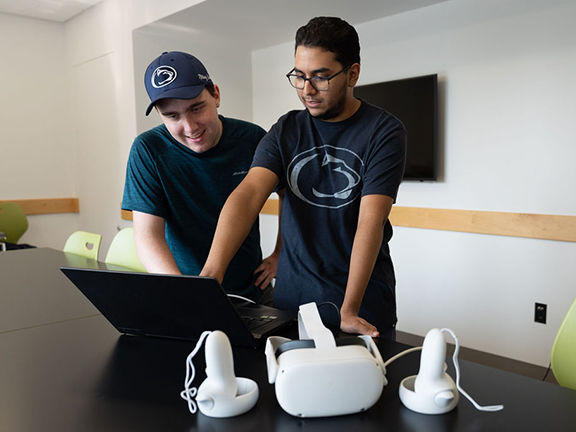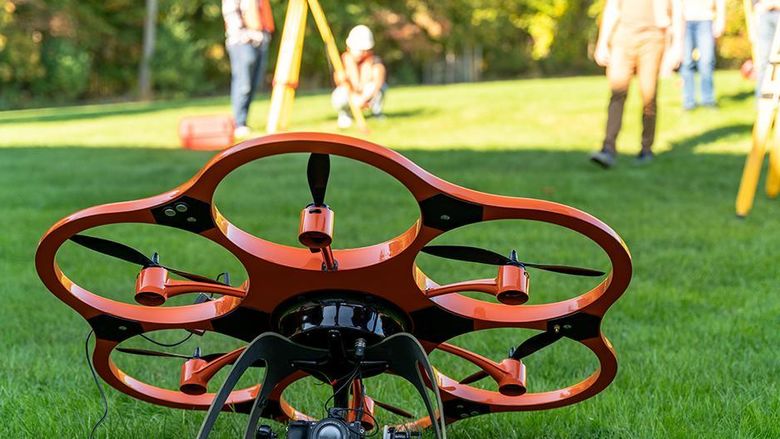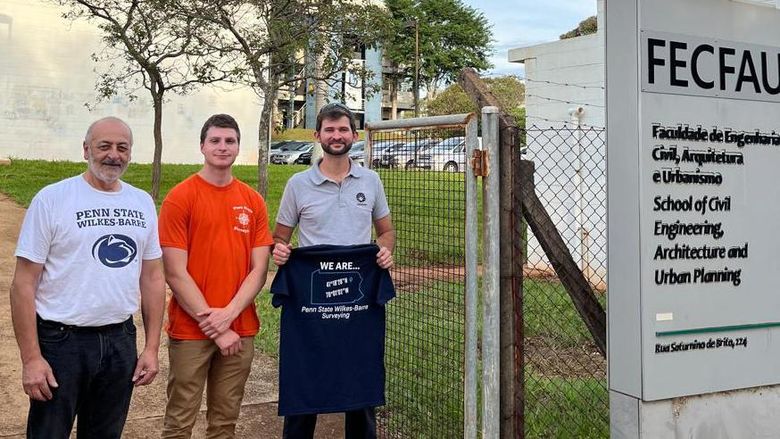
Penn State Hazleton students Kyle Jones, left, and Jason Herrera are assisting with the coding and development for virtual reality and augmented reality applications.
DALLAS, Pa. — Faculty and students at two Penn State campuses are collaborating to develop virtual reality (VR) and augmented reality (AR) applications for use in geospatial education. The project, funded with more than $10,000 from the International Society for Photogrammetry and Remote Sensing (ISPRS), focuses on how to implement VR and AR to help surveying educators better understand immersive technologies, their advantages and disadvantages, and how such technologies can be used to support instruction.
Dimitrios Bolkas, associate professor of surveying engineering at Penn State Wilkes-Barre, is leading the project, called the Education and Capacity Building Initiative. Collaborators include Jeffrey Chiampi, associate teaching professor of computer science at Penn State Hazleton, and Jason Herrera and Kyle Jones, who are both undergraduate students at Penn State Hazleton.
“In our field, we are working with new teaching methods and many of us have become more involved with immersive technologies and virtual reality,” said Bolkas, who chairs the ISPRS working group that received the funding. “This is to support the education of professionals in the field and open pathways to educate others. The modules we are developing will be available to anyone to use to explore VR and AR mode.”
The project began in the summer of 2024, when Bolkas and his colleagues in the working group surveyed educators, professionals, organization leaders and others in the surveying field on the topic of virtual reality. Participants were asked about their familiarity and experience with VR and AR and what their needs were in those areas. Based on the responses, the group decided to develop an immersive experience in mapping with the ability to visualize objects and three-dimensional models. Penn State Wilkes-Barre also used some of the funding to purchase six headsets to enable the VR/AR experience.
Chiampi, who previously taught at Penn State Wilkes-Barre, was asked to join the team for his expertise in computer science and application development. Herrera and Jones are contributing to coding and development.
Herrera and Jones are both second-year students majoring in computer science who got to know each other as students at East Stroudsburg South Senior High School.
“We both went to the same high school pursuing the same field and took the same computer science classes, so we had similar experience levels before we came to Penn State,” Herrera said. “This kind of opportunity has allowed me to learn and refine skills required for my major, like problem-solving, communication and collaboration skills. These skills will help me advance in my goals to become a successful software developer in the future. I also learned how game engines work and the limitless possibilities that virtual reality can provide.”
Students at both Penn State Hazleton and Penn State Wilkes-Barre, as well as other Penn State campuses, have the opportunity to work with faculty members on research and present their findings at campus research fairs and off-campus conferences in their fields.
“I had not worked with VR or AR before, so everything was new territory in that regard,” Jones said. “I have, however, worked on large-scale projects before, but this was definitely the largest project so far. Through being involved with the project, I learned how to use programs and platforms in my field and how to work better with a team. When I look for a job, I know that learning how to work well with a team and having a broader experience with coding will be useful to any developer.”
The first phase of the project, developing VR applications, has been completed, with AR application development in process. The VR and AR experiences will be tested in surveying and geospatial courses at Penn State Wilkes-Barre and the U.S. Military Academy at West Point during the fall semester. When complete, the researchers will offer learning materials on the immersive technologies to surveying educators for use in their courses and work.
“The goal of this project was to broaden the education of the geospatial community and share this knowledge with them,” Bolkas said. “We strive to educate our students using emerging technologies and appreciate this opportunity to make contributions to the surveying field.”





